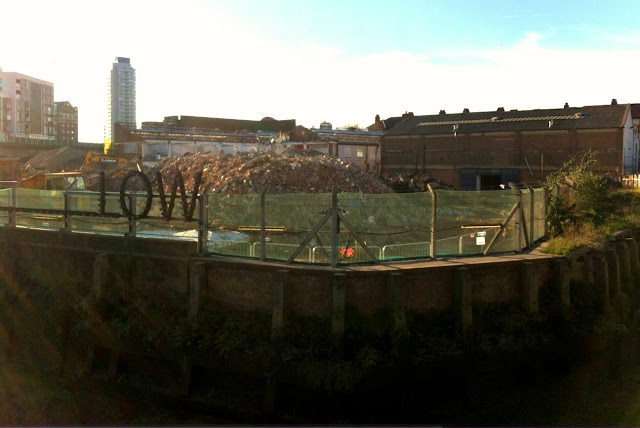Demolition of the Faircharm Industrial Estate on Deptford creekside is well underway, with the building on the river now just a pile of rubble.
 |
| How it used to look (photo taken in 2011) |
Until recently Faircharm was the home to around 130 artist studios and small businesses. The new scheme that will replace it, designed by Karakusevic Carson Architects, has been branded as The Faircharm Creative Quarter. It will include arts and studio space, but nothing like on the previous scale and no doubt nowhere near as affordable. It will also include 148 flats, of which only 21 have been classified as affordable (see Crosswhatfields for criticisms of the scheme raised during planning process in 2013).
 |
| Architect's image of new building on Faircharm |
The latest development is another chapter in the continual reshaping of this site, which in the space of 200 years has gone from agriculture, through heavy industry and art and now on to housing. I find taking the long view tempers pessimism about supposedly irreversible change, such as the assumption that Deptford is on a one way street towards excluding anybody other than the well-off. Things do change in all kinds of unpredictable ways, positive and negative. Buildings put up for one purpose end up being used for something else - after all the previous buildings on site were never built to house art spaces. Places deemed affordable become less so, but sometimes the other way round. Many of the houses built for upper middle class residents in late 19th century in SE London ended up being converted to bedsits or even squatted by the 1980s, now the tide has reversed but who knows what the future holds? It is not architecture that determines affordability, but people's incomes. All this is a long way of saying that it is not just the intention of developers that shape what happens but wider political and social trends and forces over time. And that is all still to play for.
The detailed history of the area is covered in Lewisham Planning's very interesting Deptford Creekside Conservation Area Appraisal (2012):
'Up until the early 19th century the land to both sides of the Creek was mainly in use as meadows and market gardening. The area today covered by the Faircharm Estate and the Crossfield Housing Estate was common pasture for Deptford in 1608. This land was bought by John Addey’s charity and became known as the Gravel Pits Estate. On the 1745 Rocque Map it is marked as a ‘Gravel Pit’ with a few scattered buildings and market gardens around it...
Between the gravel pits and Church Street in the area of today’s Browne House of the Crossfield Estate, a house of correction, the Deptford Bridewell, was constructed in 1707. The Bridewell was an early form of prison, focusing on vagrants and idle paupers. It closed in 1721 and was soon afterwards converted into a workhouse known as St. Paul’s Workhouse. It was enlarged in the late 18th and early 19th century but closed in the late 1830s.
The 19th century saw the industrialisation of the river banks of Deptford and the Creek. New privately owned shipyards and boilerworks appeared on the Thames waterfront and a variety of new industries along the Creek, many of which were unpleasant and ‘dirty’ industries: as early as 1852 The Kentish Mercury listed chemical works, breweries, bleach, dye and glue works, tar distelleries and manure manufacture, making the Creek area ‘one great stinking abomination’.
Deptford became a synonym for industry. A Guide to Greenwich and Deptford published in 1893 described the area occupied by ‘almost every industry of importance (…) and the admirable facilities it offers for manufacturing purposes causes the rents in the neighbourhood to stand abnormally high.’ In 1836, London’s first railway, the London to Greenwich Railway, reached Deptford. Much of its four mile route was elevated on a continuous 878-arch brick viaduct bridged over the Creek by a drawbridge.
On the Deptford Creekside, one of the first notable areas of intensification was in the area south of the railway line on the site of today’s Faircharm Estate. The Beneke family founded its verdigris works for the manufacture of copper sulphate here in 1814. This became the Deptford Chemical Works and passed to Frank Hills in c1840 who operated a vitriol distillery here. The Chemical Works continued in his family until the early 20th century.
The use of the Chemical Works on the site today occupied by Faircharm ceased some time around 1945, possibly as a result of war damage. The site was subsequently cleared and redeveloped... The existing buildings date from the late 1940s, 1950s and early 1960s and include a variety of workshop and warehouse buildings... The warehouses were once occupied by the Lewisham based company Zenith Carburetters whose name still appears at the front'.





.jpg)













1 comment:
Hi,
I am an Architecture Student at the Bartlett in London. I am doing a research project on the Faircharm Creative Quarter and I am really interested in what you have written in your blog posts about it.
I was wondering if you would be free to take a walk around the site, or alternatively due to the current climate, arrange a phone call? I would love to ask you more about the development of this space, and its successes and failures.
I look forward to hearing from you.
Thank you very much for your time.
Best wishes,
Mahika
Post a Comment